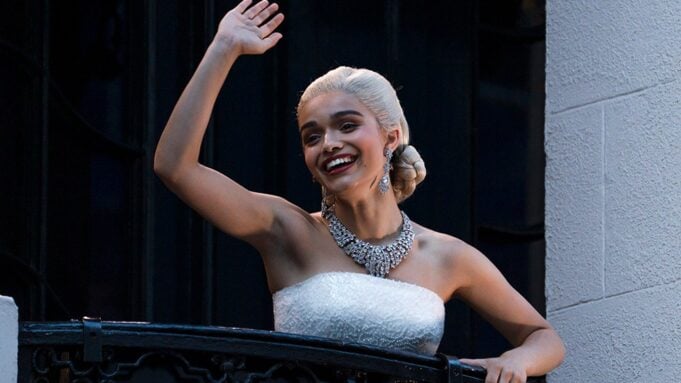Rachel Zegler is perched on a balcony, looking down graciously at a crowd of her adoring supporters. No, this isn’t a meet-and-greet for the “Snow White” and “West Side Story” star – she’s belting “Don’t Cry for Me Argentina,” the soulful climax of Andrew Lloyd Webber and Tim Rice’s classic musical “Evita,” embodying the glamorous First Lady of Argentina the show is based on in a sparkling gown and platinum blonde wig.
But the people Zegler is serenading aren’t those inside the London Palladium who have paid top-dollar to see her in avant-garde director Jamie Lloyd‘s latest endeavor. They are her fans, bystanders and anyone who happens to walk down Soho’s Argyll Street at 9 p.m., getting a free front-row seat (or shall I say, stand) to one of the must buzzed about performances of the year. As for the actual audience? They’re watching Zegler’s performance via video stream, projected onto the stage.
“Evita” only just officially opened on Tuesday night, but already much noise has been made about the controversial decision by Lloyd — fresh off three Tony wins for his Broadway run of “Sunset Boulevard,” which employed similar camera techniques — to have his star perform the musical’s biggest number outside of the theater. After previews started two weeks ago and the move was revealed, many disappointed fans took to social media to lament (“Sorry, are you saying I’ve paid £350 for 2 tickets and she’s singing the biggest number outside at people who haven’t paid?” one user posted) while critics also took aim at the stunt (“People who have paid a lot of money to sit in a theater may reasonably expect that the most important songs in a musical will be sung in front of them,” wrote The Guardian’s Mark Lawson). But, as I watched the show in awe on opening night, it became very clear that this divisiveness is exactly the point Lloyd is trying to make.
At the center of “Evita,” and the song “Don’t Cry for Me Argentina” — which Eva Perón sings after her husband Juan is elected president — is an exploration of class conflict and how she rose through the ranks, despite it all, to achieve her dreams. But Perón was a controversial figure. Though she was beloved by many Argentinians because of her rags-to-riches story and charitable initiatives, there are some who, looking back, have questioned her legacy, arguing she was simply a fascist with a flashy facade. This point of view is represented in the show by Che (portrayed expertly by Diego Andres Rodriguez), a critical narrator who helps the audience see through Perón’s glitz and glam. Though her love for the people of Argentina was true, Evita got caught up in her own ambition and fell into hypocrisy — dressing head-to-toe in Christian Dior while telling the country’s poor she was one of them, chasing power by running for vice president even though she knew her health was failing. There has even been speculation that she siphoned some of the funds her foundation collected from the Argentinian people into Swiss bank accounts, despite the impact it had on healthcare and general welfare in the country. However, “Evita” is also quick to point out that she was never fully accepted into high society and was always looked down upon because of her lower class background, which is part of the reason why she started her foundation in the first place.

Marc Brenner
Class divisions are also deeply embedded into the history of theater, particularly because being able to watch and enjoy it is traditionally reserved for high-class society. Therefore, having Zegler perform the show’s biggest moment to a crowd of people on the street — as Perón would have in real-life — returns the power to the people, as she sought to, and reminds us that the art form itself is a privilege. As the show makes clear, Perón knew how to manipulate a man, a country, the world to get what she wanted. With this radical act of theater, Lloyd is similarly manipulating the expectations of those who bought tickets to the show. And by sparking such strong emotion on either side, he’s proven that despite how many people call the staging a gimmick or spectacle, it’s still got them talking — and wanting to see what all the buzz is about.
Love Film & TV?
Get your daily dose of everything happening in music, film and TV in Australia and abroad.
Indeed, Tuesday’s premiere was a starry affair — Keanu Reeves and Laurence Fishburne showed up together in a “Matrix” reunion, Richard E. Grant and Sarah Paulson chatted away before the show and Pedro Pascal paused to take selfies with fans. Both Lloyd and Webber came dressed in “Evita” blue (Lloyd opted for his signature hoodie, while Webber wore a velvet sports coat). Even Piers Morgan, who was openly critical of Zegler’s “Snow White” casting, was there. The balcony stunt clearly didn’t deter the crowd from expressing its enthusiasm throughout, standing for two ovations during the show after impressively choreographed renditions of “Buenos Aires” and “And the Money Kept Rolling In (and Out).”
Although it undoubtedly would have been dazzling to see Zegler perform “Don’t Cry for Me Argentina” on stage surrounded by an audience of boldfaced names, watching it on a screen is still extremely effective. With multiple camera angles, theatergoers also get a glimpse at the massive crowd that has shown up to watch Zegler sing, adding a dose of reality to a fictionalized show. Audible gasps echoed across the theater as hundreds of fans on the street appeared over Zegler’s shoulder, accompanied by several utterances of “Jesus Christ” and “holy shit.” It was a powerful moment to see, and places the character of Perón in a much more regal light than could likely be accomplished within four walls. Plus, the performance of Zegler — who, by the way, was born to play this role — is in no way inhibited by the screen. Close-up camera angles show every movement of her face, the tears that eventually flow down, the real exhilaration she must feel being part of a moment like this. Pair that with her powerhouse vocals, and it’s no wonder both the crowds inside and outside of the Palladium equally roared in applause as the song concluded and Zegler made her way back to the stage.
Besides all of its artistic and intellectual value, Lloyd’s staging of “Don’t Cry for Me Argentina” is also just good marketing. The headlines it’s made will without a doubt drive up the already sky-high demand for tickets even further. And for everyone who gets to see Zegler perform on the balcony, you can bet they’ll be trying to get a ticket any way they can to experience the show in full (Lloyd is certainly doing his best to make it accessible with last-minute tickets available on the door and a £25 deal for attendees who are under 30, key workers or on government benefits). For Zegler, Lloyd and “Evita,” the money is sure to keep rolling in — and its rainbow tour is almost guaranteed to include a stop on Broadway (and at the Tonys).
From Variety US































